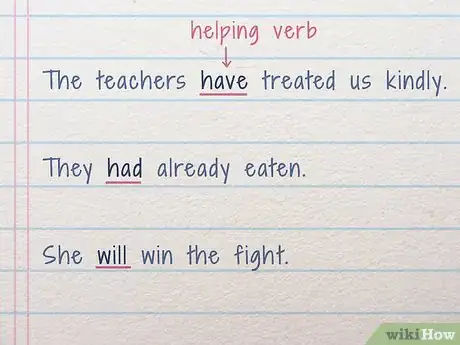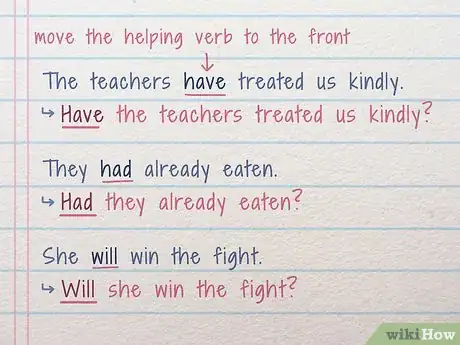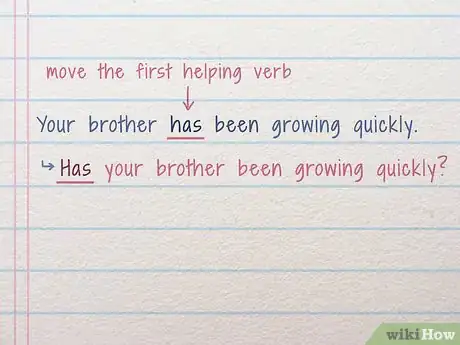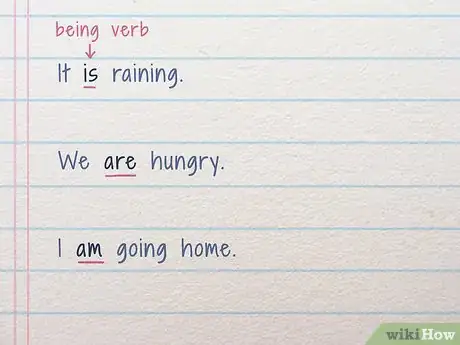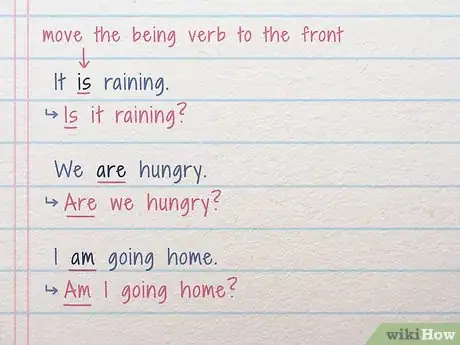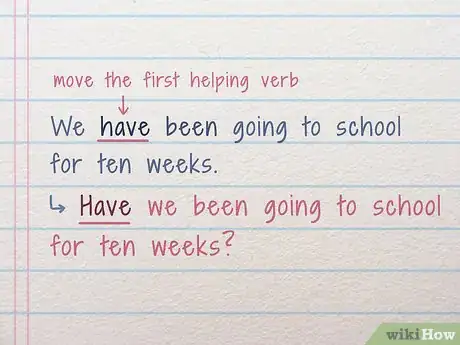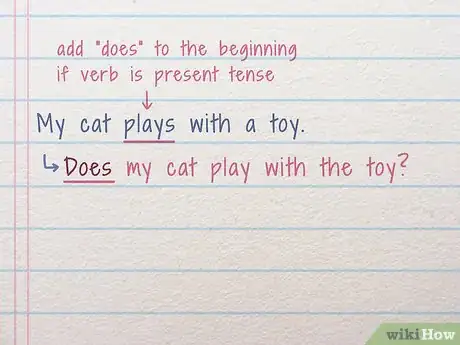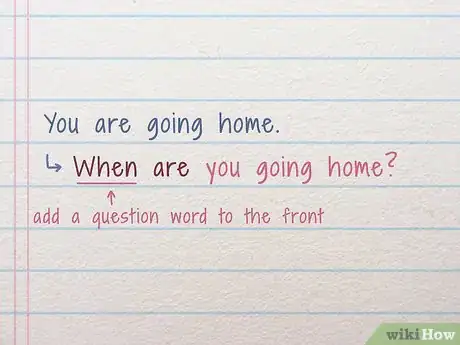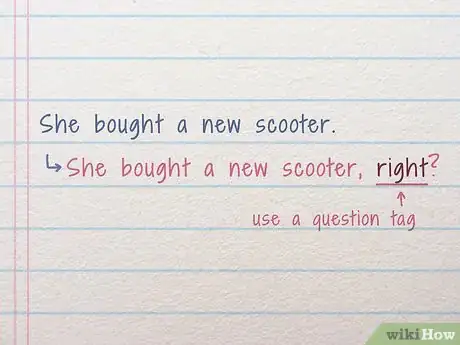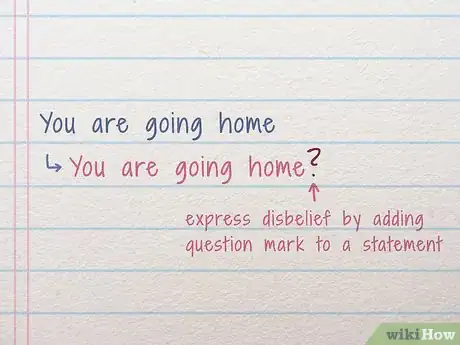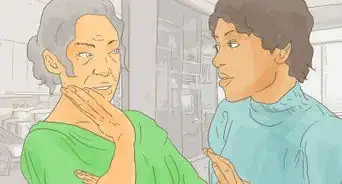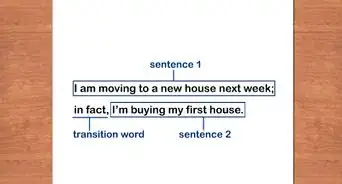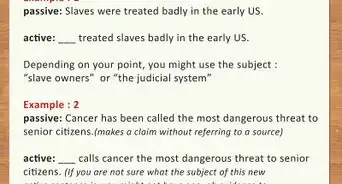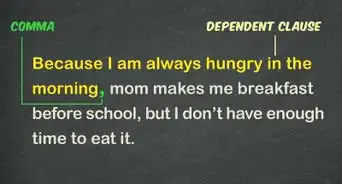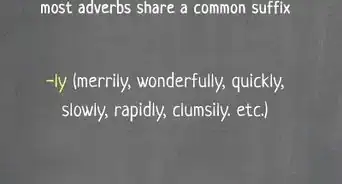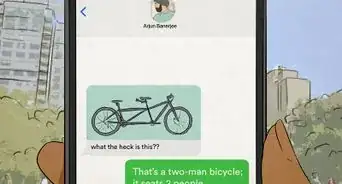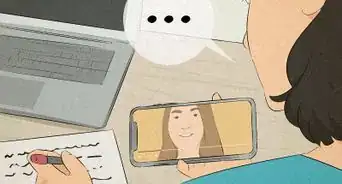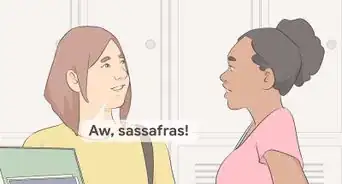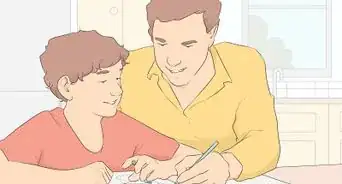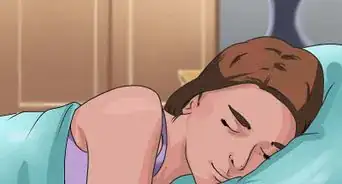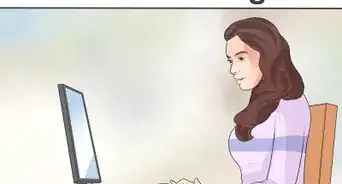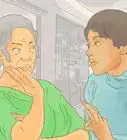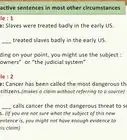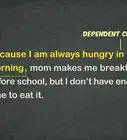This article was co-authored by Language Academia and by wikiHow staff writer, Danielle Blinka, MA, MPA. Language Academia is a private, online language school founded by Kordilia Foxstone. Kordilia and her team specialize in teaching foreign languages and accent reduction. Language Academia offers courses in several languages, including English, Spanish, and Mandarin.
This article has been viewed 469,538 times.
Turning a statement into a question can seem really hard at first, but it might be easier than you think. You use a statement to express a fact, opinion, or viewpoint about a topic. On the other hand, you ask questions to get information from others. You can easily change a statement to a question by moving the helping verb, moving the being verb, or adding a doing verb. Additionally, you can add a question word or question tag to get specific information.
Steps
Moving the Helping Verb
-
1Look for a helping verb in the sentence. Common helping verbs include have, has, and had. Additionally, words like “should,” “would,” “could,” “might,” “may,” and “will” are helping verbs. Re-read the sentence to see if it has any helping verbs. Here are examples of sentences with the helping verb bolded:[1]
- The teachers have treated us kindly.
- They had already eaten.
- She will win the fight.
- My cat would climb that tree.
- A pie can feed eight people.
- We shall meet again.
- I was standing.
Tip: Check for helping verbs in contractions. For example, in the sentence “We’ll go to school,” “we’ll” is a contraction of “we will.” “Will” is a helping verb. Similarly, “hasn’t” is a contraction of “has not,” and “has” is a helping verb.
-
2Move the helping verb to the front of the sentence to make a question. Rewrite the sentence with the helping verb as the first word. Leave the other words in the same place and write them exactly as they appear in the statement. This will turn your statement into a question. Here are some examples:[2]
- The teachers have treated us kindly. → Have the teachers treated us kindly?
- They had already eaten. → Had they already eaten?
- She will win the fight. → Will she win the fight?
- My cat would climb that tree. → Would my cat climb that tree?
- That pie can feed eight people. → Can that pie feed eight people?
- We shall meet again. → Shall we meet again?
- I was standing. → Was I standing?
Advertisement -
3Use the first helping verb if the sentence has more than 1 helping verb. Sometimes you’ll have a sentence that includes more than 1 helping verb to describe an action. For instance, you might say “will have taken” or “could have been.” In this case, only move the first helping verb to the front of the sentence. Leave the remaining words where they are. Look at these examples:[3]
- Your brother has been growing quickly. → Has your brother been growing quickly?
- I could have been studying. → Could I have been studying?
Shifting a Being Verb
-
1Look for a being verb in the sentence. Being verbs are the “be” verbs, such as “am,” “is,” “are,” were,” and “was.” These verbs tell you a person’s current state or what they are doing. Check the sentence to see if it has a being verb. Here are some example sentences with the being verb bolded:[4]
- It is raining.
- We are hungry.
- I am going home.
- You were there last night.
- The cat was playing with that toy.
-
2Move the being verb to the beginning of the sentence to form a question. Rewrite the sentence with the being verb at the beginning. Don’t change any other words in the sentence. This will change the statement into a question. Look at these examples:[5]
- It is raining. → Is it raining?
- We are hungry. → Are we hungry?
- I am going home. → Am I going home?
- You were there last night. → Were you there last night?
- The cat was playing with that toy. → Was the cat playing with that toy?
- If you use the verb to be, you can change the place of the verb and the subject.
- For example, I am Irish can be transformed into a question by changing the place and form of the verb and pronoun to the required form. So I am Irish will become Are you Irish?
-
3Look for a helping verb if you see the word “been.” The word “been” is a being verb, but it’s typically used with a helping verb. Don’t move “been” to the beginning of a sentence to form a question. Use the helping verb instead of “been.”[6]
- For example, the word “been” appears in this sentence: “We have been going to school for ten weeks.” Notice that “have” is used here as a helping verb. That means you’d form a question by writing, “Have we been going to school for ten weeks?”
Adding Does, Do, or Did
-
1Add “does” to the beginning of the sentence if the verb is present tense. Check to see if the subject of your sentence is singular. Then, make sure the verb is present tense. If both of these are true, add the word “does” to the beginning of the sentence to turn it into a question. Then, change the verb back to its base form by dropping “s” from the end.[7]
- My cat plays with a toy. → Does my cat play with the toy?
- My friend takes the bus. → Does my friend take the bus?
-
2Use "do" for plural subjects or "you.” Look at the subject to see if it’s plural or “you,” then check to see if the verb is present tense. If so, add the word “do” at the beginning of the sentence to change the statement to a sentence.[8]
- They greet their teacher. → Do they greet their teacher?
- The protesters call for change. → Do the protesters call for change?
- You throw stones at my window. → Do you throw stones at my window?
-
3Put "did" at the front of the sentence for simple past tense verbs. Check to see if your verb is in the past tense. If it is, use the word “did” to transform the statement into a question, whether the subject is singular or plural. Add the word “did” at the beginning of the sentence and change the verb back to its base, present tense form.[9]
- He saved the cat. → Did he save the cat?
- The sheep jumped over the fence. → Did the sheep jump over the fence?
- He broke my oven. → Did he break my oven?
Tip: If the verb has a helping verb, use the helping verb technique instead.
Trying Other Methods
-
1Add a question word to the start of a question to make it more specific. Question words include “who,” “what,” “where,” “why,” “when,” and “how.” Use these words when you want the answer to your question to include specific details. First, change the statement into a question using a helping verb, being verb, or doing verb. Then, add a question word to the beginning of the question to make it more specific.[10]
- You can add a question word at the beginning of a sentence to indicate what the question is referring to specifically.
- You are going home. → When are you going home?
- The cat caught the mouse. → How did the cat catch the mouse?
-
2Use a question tag to easily form a yes/no question. Question tags go at the end of a statement to turn it into a question. Make a question tag using the word “right,” a helping verb, or a being verb. To turn the statement into a question, put a comma, then add the question tag. Leave the rest of the sentence the same. Here are some examples:[11]
- She bought a new scooter. → She bought a new scooter, right?
- He was at the party. → He was at the party, wasn’t he?
- They went to the store yesterday. → They went to the store yesterday, didn’t they?
-
3Add a question mark to a statement to express disbelief. Adding a question mark at the end of a statement instantly turns it into a question. Change the period to a question mark when you are confused about what is happening. Typically, these questions have a “yes” or “no” answer. Here are some examples:[12]
- You are going home. → You are going home?
- She's a scientist. → She's a scientist?
- We have school tomorrow. → We have school tomorrow?
Community Q&A
-
QuestionWhat are some different types of questions?
 wikiHow Staff EditorThis answer was written by one of our trained team of researchers who validated it for accuracy and comprehensiveness.
wikiHow Staff EditorThis answer was written by one of our trained team of researchers who validated it for accuracy and comprehensiveness.
Staff Answer wikiHow Staff EditorStaff AnswerCommon types include closed questions, which you can typically answer with “yes” or “no” (or another specific piece of information, such as your name); open questions, which require a more elaborate response (e.g., “What did you think of the movie?”); or rhetorical questions, which are not really meant to be answered (such as, “Who doesn’t like a good movie?”).
wikiHow Staff EditorStaff AnswerCommon types include closed questions, which you can typically answer with “yes” or “no” (or another specific piece of information, such as your name); open questions, which require a more elaborate response (e.g., “What did you think of the movie?”); or rhetorical questions, which are not really meant to be answered (such as, “Who doesn’t like a good movie?”). -
QuestionWhat is a tag question?
 wikiHow Staff EditorThis answer was written by one of our trained team of researchers who validated it for accuracy and comprehensiveness.
wikiHow Staff EditorThis answer was written by one of our trained team of researchers who validated it for accuracy and comprehensiveness.
Staff Answer wikiHow Staff EditorStaff AnswerA tag question is a brief question phrase that you can place at the end of a statement to turn it into a question. For example, “He looks good, doesn’t he?” or “You cook really well, don’t you?” Tag questions usually work by offering a negative alternative to the statement, but some use a positive instead (e.g., “You’re 12 years old, right?”).
wikiHow Staff EditorStaff AnswerA tag question is a brief question phrase that you can place at the end of a statement to turn it into a question. For example, “He looks good, doesn’t he?” or “You cook really well, don’t you?” Tag questions usually work by offering a negative alternative to the statement, but some use a positive instead (e.g., “You’re 12 years old, right?”). -
QuestionWhat’s an example of a statement sentence?
 wikiHow Staff EditorThis answer was written by one of our trained team of researchers who validated it for accuracy and comprehensiveness.
wikiHow Staff EditorThis answer was written by one of our trained team of researchers who validated it for accuracy and comprehensiveness.
Staff Answer wikiHow Staff EditorStaff AnswerA statement is any sentence that simply presents information. For example, “Cats eat meat,” “I like bananas,” or “My name is Bertie.”
wikiHow Staff EditorStaff AnswerA statement is any sentence that simply presents information. For example, “Cats eat meat,” “I like bananas,” or “My name is Bertie.”
References
- ↑ https://www.englishclub.com/grammar/sentence/type-interrogative.htm
- ↑ https://www.englishclub.com/grammar/sentence/type-interrogative.htm
- ↑ https://www.englishclub.com/grammar/sentence/type-interrogative.htm
- ↑ https://www.educationquizzes.com/in/primary/english/sentences-4-convert-statements-to-questions/
- ↑ https://www.educationquizzes.com/in/primary/english/sentences-4-convert-statements-to-questions/
- ↑ https://www.englishclub.com/grammar/sentence/type-interrogative.htm
- ↑ https://www.englishgrammar.org/change-statement-questions/
- ↑ https://www.englishgrammar.org/change-statement-questions/
- ↑ https://www.englishgrammar.org/change-statement-questions/
About This Article
To change a statement to a question, first look for the helping verb in the sentence, like “Have,” “Would,” “Can,” or “Was.” Then, move the helping verb to the front of the sentence and add a question mark at the end. For example, “I was standing,” becomes, “Was I standing?” For sentences with longer helping verbs, like “could have been,” only move 1 helping word. For instance, in “I could have been studying,” move the “Could,” to the beginning to make it, “Could I have been studying?” In some cases, you may need to use "Do" or "Does" at the beginning, like “He cleans the bedroom,” which becomes, “Does he clean the bedroom?” For more tips, including how to add question words to make a statement into a question, read on!
